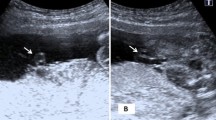Abstract
Purpose
To evaluate blood flow Doppler velocimetry during the first and second stages of active labor.
Methods
A prospective observational study was performed. Patients at term (37–42 weeks gestation), with normal fetal heart rate tracing patterns (categorized as category I) were examined during the first and second stages of labor. The sonographic parameters that were measured included the blood flow resistance of the maternal uterine artery (UtA) and umbilical artery (UA). Wilcoxon-matched pair test was used for the comparison of flows between the first and the second stages of labor.
Results
UtA and UA Doppler velocimetry measurements were obtained from 31 parturients. The left (LT) and right (RT) UtA pulsatility index (PI) was lower in the second stage of labor as compared with the first stage. However, only the LT side reached a statistically significant difference (0.88 ± 0.32 and 0.73 ± 0.18; P = 0.005). Compared with the first stage of labor, UA PI was significantly higher during the second stage of labor (0.72 ± 0.17 vs. 0.84 ± 0.33; respectively, P = 0.05).
Conclusion
Significant blood flow resistance changes in maternal as well as in fetal blood vessels occur during the second stage as compared with the first stage of active labor.
Similar content being viewed by others
References
Groom KM, North RA, Stone PR et al (2009) Patterns of change in uterine artery Doppler studies between 20 and 24 weeks of gestation and pregnancy outcomes. Obstet Gynecol 113:332–338
Burton GJ, Woods AW, Jauniaux E, Kingdom JC (2009) Rheological and physiological consequences of conversion of the maternal spiral arteries for uteroplacental blood flow during human pregnancy. Placenta 30:473–482
Li H, Gudmundsson S, Olofsson P (2004) Clinical significance of uterine artery blood flow velocity waveforms during provoked uterine contractions in high-risk pregnancy. Ultrasound Obstet Gynecol 24:429–434
Kurjak A, Dudenhausen JW, Kos M et al (1996) Doppler information pertaining to the intrapartum period. J Perinat Med 24:271–276
Somerset DA, Murrills AJ, Wheeler T (1993) Screening for fetal distress in labour using the umbilical artery blood velocity waveform. Br J Obstet Gynaecol 100:55–59
Farrell T, Chien PF, Gordon A (1999) Intrapartum umbilical artery Doppler velocimetry as a predictor of adverse perinatal outcome: a systematic review. Br J Obstet Gynaecol 106:783–792
Kassanos D, Siristatidis C, Vitoratos N, Salamalekis E, Creatsas G (2003) The clinical significance of Doppler findings in fetal middle cerebral artery during labor. Eur J Obstet Gynecol Reprod Biol 109:45–50
Cheema R, Dubiel M, Gudmundsson S (2009) Signs of fetal brain sparing are not related to umbilical cord blood gases at birth. Early Hum Dev 85:467–470
Siristatidis C, Salamalekis E, Kassanos D, Loghis C, Creatsas G (2004) Evaluation of fetal intrapartum hypoxia by middle cerebral and umbilical artery Doppler velocimetry with simultaneous cardiotocography and pulse oximetry. Arch Gynecol Obstet 270:265–270
American College of Obstetricians and Gynecologists (2009) ACOG practice bulletin No. 106: intrapartum fetal heart rate monitoring: nomenclature, interpretation, and general management principles. Obstet Gynecol 114:192–202
Selim MF, Elnabtity AM, Hasan AM (2012) Comparative evaluation of epidural bupivacaine—dexmedetomidine and bupivacaine-fentanyl on Doppler velocimetry of uterine and umbilical arteries during labor. J Prenat Med 6:47–54
Valentin M, Ducarme G, Ceccaldi PF, Bougeois B, Luton D (2012) Uterine artery, umbilical, and fetal cerebral Doppler velocities after epidural analgesia during labor. Int J Gynaecol Obstet 118:145–148
Redman CW, Sargent IL (2005) Latest advances in understanding preeclampsia. Science 308:1592–1594
Conflict of interest
The authors report no conflict of interest.
Author information
Authors and Affiliations
Corresponding author
Rights and permissions
About this article
Cite this article
Baron, J., Shwarzman, P., Sheiner, E. et al. Blood flow Doppler velocimetry measured during active labor. Arch Gynecol Obstet 291, 837–840 (2015). https://doi.org/10.1007/s00404-014-3489-9
Received:
Accepted:
Published:
Issue Date:
DOI: https://doi.org/10.1007/s00404-014-3489-9



